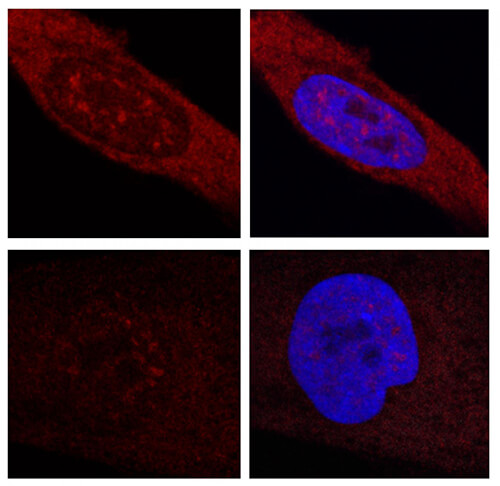



Huntington’s disease is a neurodegenerative disease that is presently incurable. Scientists around the world are researching its causes and molecular processes in the attempt to find a treatment.

A team of researchers from the Centre for Genomic Regulation (CRG) in Barcelona, in cooperation with investigators from the University of Barcelona (UB) and August Pi i Sunyer Biomedical Research Institute (IDIBAPS) just published new information on the molecular mechanisms that cause Huntington’s disease (HD)—establishing potential new pathways toward therapeutic discovery. The findings from this new study were published recently in the Journal of Clinical Investigation in an article entitled “Targeting CAG Repeat RNAs Reduces Huntington’s Disease Phenotype Independently of Huntingtin Levels.”
The disorder is caused by the excessive repetition of a nucleotide triplet (CAG) in the huntingtin gene (HTT). The number of CAG repetitions varies from person to person. The repeat expansion threshold seems to lie around 36, with those individuals exhibiting severe Huntington’s symptoms typically having 40 or more repeats. The direct consequence of these excess repetitions is the synthesis of a mutated protein different from what would be obtained without the additional CAG repetitions—which has been considered the primary cause of the disease for the past 20 years.
“What we have observed in our study is that the mutated fragment was acting as a conveyor—the so-called messenger RNA (mRNA)—is key in the pathogenesis,” explained co-senior study investigator Eulàlia Martí, Ph.D., acting group leader of the Genes and Disease Laboratory at the Centre for Genomic Regulation. “The research on this disease being done by most groups around the world seeking new therapeutic strategies focuses on trying to prevent expression of the mutated protein. Our work suggests that blocking the activity of messenger RNA (the “conveyor”) would be enough to revert the alterations associated with HD. We hope this will contribute to improving the strategies in place to find a cure.”
Diving deeper in molecular mechanisms that control Huntington’s enables progress toward future applications, the researchers sought to identify whether the problem resided in the mRNA—which would be the copy responsible for manufacturing the protein—or in the resulting protein. Previous work indicated that the mRNA produced, in addition to a defective protein, other damage. These studies provided a starting point for the scientists, who were able to demonstrate that mRNA has a key role in the pathogenesis of Huntington’s Disease.
“We have shown that a locked nucleic acid–modified antisense oligonucleotide complementary to the CAG repeat (LNA-CTG) preferentially binds to mutant HTT without affecting HTT mRNA or protein levels,” the authors wrote. “LNA-CTGs produced rapid and sustained improvement of motor deficits in an R6/2 mouse HD model that was paralleled by persistent binding of LNA-CTG to the expanded HTT exon 1 transgene. Motor improvement was accompanied by a pronounced recovery in the levels of several striatal neuronal markers severely impaired in R6/2 mice. Furthermore, in R6/2 mice, LNA-CTG blocked several pathogenic mechanisms caused by expanded CAG RNA, including small RNA toxicity and decreased Rn45s expression levels.”
This current work underscores the importance of rethinking the mechanisms behind illnesses to find new treatments. The CRG researchers helped explore the molecular mechanisms that cause the disease. Now, their results will contribute to better delimiting research efforts toward a cure.
“The research we have just published points to RNA’s clear role in Huntington’s disease,” Dr. Martí stated. “This information is very important in translational research to take on new treatments.”
The investigators were excited by their findings but stated that more in-depth studies on these mechanisms need to be performed. For example, research must explore whether it will be possible to revert the effects of HD in patients, just as researchers have demonstrated in mouse models. Moreover, it remains to be seen whether the proposal of the CRG researchers can be used in a preventive way, as the disease does not generally appear until after 40 years of age in humans. Despite the remaining gaps, the newly published work makes for a critical step in knowledge of the mechanisms of this neurodegenerative disease that, as of today, remains incurable.
 Relevant
news
Relevant
news